Sources
![]() This article incorporates text from a publication now in the public domain : Herbermann, Charles, ed. (1913). "Rhodo". Catholic Encyclopedia . New York: Robert Appleton Company.
This article incorporates text from a publication now in the public domain : Herbermann, Charles, ed. (1913). "Rhodo". Catholic Encyclopedia . New York: Robert Appleton Company.
Rhodo was a Christian writer who flourished in the time of the Roman emperor Commodus (180-92); he was a native of the province of Asia Minor who came to Rome where he was a pupil of Tatian.
He wrote several books, two of which are mentioned by Eusebius of Caesarea: [1] a treatise on "The Six Days of Creation", and a work against the Marcionites, in which he focussed upon the various opinions which divided them. Eusebius, upon whom modern historians depend exclusively for our knowledge of Rhodo, quotes some passages from the latter work, in one of which an account is given of the Marcionite Apelles.
Jerome's De Viris Illustribus amplifies Eusebius's account somewhat by making Rhodo the author of a work against the Cataphrygians: probably he had in mind an anonymous work quoted by Eusebius a little later. [2]
![]() This article incorporates text from a publication now in the public domain : Herbermann, Charles, ed. (1913). "Rhodo". Catholic Encyclopedia . New York: Robert Appleton Company.
This article incorporates text from a publication now in the public domain : Herbermann, Charles, ed. (1913). "Rhodo". Catholic Encyclopedia . New York: Robert Appleton Company.
Eusebius of Caesarea, also known as Eusebius Pamphilius, was a Greek Syro-Palestinian historian of Christianity, exegete, and Christian polemicist. In about AD 314 he became the bishop of Caesarea Maritima in the Roman province of Syria Palaestina.

The First Council of Nicaea was a council of Christian bishops convened in the Bithynian city of Nicaea by the Roman Emperor Constantine I. The Council of Nicaea met from May until the end of July 325.
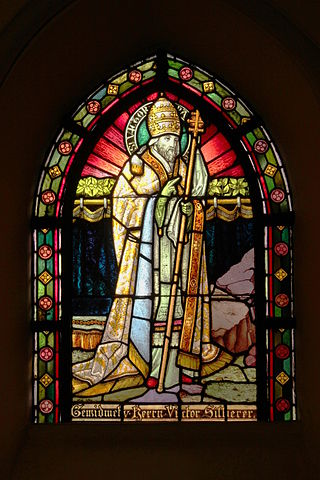
Pope Victor I was a Roman African prelate of the Catholic Church who served as Bishop of Rome in the late second century. The dates of his tenure are uncertain, but one source states he became pope in 189 and gives the year of his death as 199. He was born in the Roman Province of Africa—probably in Leptis Magna. He was later considered a saint. His feast day is celebrated on 28 July as "St Victor I, Pope and Martyr". He was of Berber origin.

Theodoret of Cyrus or Cyrrhus was an influential theologian of the School of Antioch, biblical commentator, and Christian bishop of Cyrrhus (423–457).

Pope Soter was the bishop of Rome from c. 167 to his death in c. 174. According to the Annuario Pontificio, the dates may have ranged from 162–168 to 170–177. He was born in Fondi, Campania, today in the Lazio region of Italy. Soter is known for declaring that marriage was valid only as a sacrament blessed by a priest and also for formally inaugurating Easter as an annual festival in Rome. His name, from Greek Σωτήριος from σωτήρ "saviour", would be his baptismal name, as his lifetime predates the tradition of adopting papal names.

Arius was a Cyrenaic presbyter and ascetic. He has been regarded as the founder of Arianism, which holds that Jesus Christ was not coeternal with God the Father, but was rather created before time. Arian theology and its doctrine regarding the nature of the Godhead showed a belief in subordinationism, a view notably disputed by 4th century figures such as Athanasius of Alexandria.
Marcionism was an early Christian dualistic belief system that originated with the teachings of Marcion of Sinope in Rome around 144 AD. Marcion was an early Christian theologian, evangelist, and an important figure in early Christianity. He was the son of a bishop of Sinope in Pontus. About the middle of the 2nd century (140–155) he traveled to Rome, where he joined the Syrian Gnostic Cerdo.

Theophilus was Patriarch of Antioch from 169 until 182. He succeeded Eros c. 169, and was succeeded by Maximus I c. 183, according to Henry Fynes Clinton, but these dates are only approximations. His death probably occurred between 183 and 185.
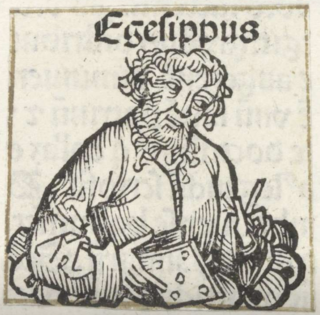
Hegesippus, also known as Hegesippus the Nazarene, was a Christian writer of the early Church who, in spite of his Greek name, may have been a Jewish convert and certainly wrote against heresies of the Gnostics and of Marcion.

According to Christian tradition, the Image of Edessa was a holy relic consisting of a square or rectangle of cloth upon which a miraculous image of the face of Jesus Christ had been imprinted—the first icon. The image is also known as the Mandylion, in Eastern Orthodoxy, it is also known as Acheiropoieton.
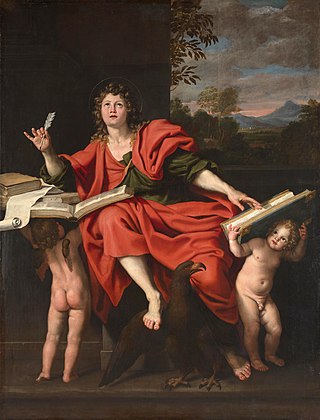
The authorship of the Johannine works has been debated by biblical scholars since at least the 2nd century AD. The debate focuses mainly on the identity of the author(s), as well as the date and location of authorship of these writings.

Simeon of Jerusalem, or Simon of Clopas, was a Jewish Christian leader and according to most Christian traditions the second Bishop of Jerusalem, succeeding James, brother of Jesus. Simeon is sometimes identified with Simon, brother of Jesus, and has also been identified with the Apostle Simon the Zealot.
Apelles was a second-century Gnostic Christian thinker. He began his ministry as a disciple of Marcion of Sinope, likely in Rome. However, at some point, Apelles either left or was expelled from the Marcionite church.
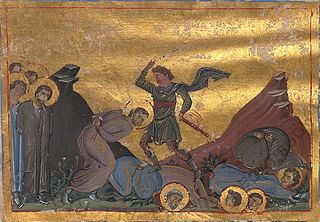
Saint Pamphilus, was a presbyter of Caesarea and chief among the biblical scholars of his generation. He was the friend and teacher of Eusebius of Caesarea, who recorded details of his career in a three-book Vita that has been lost.
The Book of Nepos was a 3rd-century Christian text written by an Egyptian bishop of Arsinoe named Nepos, which advocated for a strictly literal interpretation of the Bible, thus against allegorical readings. This included especially a literal reading of the Book of Revelation, a minority position at the time.

St. Lucifer of Cagliari was a bishop of Cagliari in Sardinia known for his passionate opposition to Arianism. He is venerated as a Saint in Sardinia.

Artemon, a prominent Christian teacher in Rome, who held Adoptionist, or Nontrinitarian views. Little is known about his life.

The Ecclesiastical History, also known as The History of the Church and Church History, is a 4th-century chronological account of the development of Early Christianity from the 1st century to the 4th century, composed by Eusebius, the bishop of Caesarea. It was written in Koine Greek and survives also in Latin, Syriac, and Armenian manuscripts.
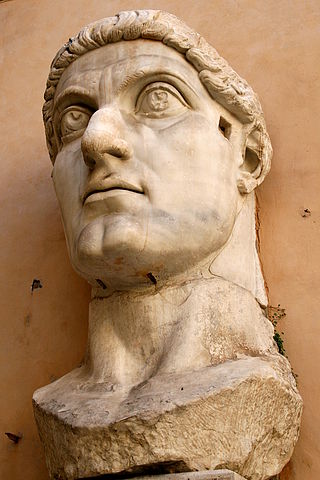
Life of Constantine the Great is a panegyric written in Greek in honor of Constantine the Great by Eusebius of Caesarea in the 4th century AD. It was never completed due to the death of Eusebius in 339. The work provides scholars with one of the most comprehensive sources for the religious policies of Constantine's reign. In addition to detailing the religious policies of the Roman Empire under Constantine, Eusebius uses Life of Constantine to engage several of his own religious concerns, such as apologetics, as well as a semi-bibliographic account of Constantine.
Philip's daughters are four women briefly mentioned in the Bible.